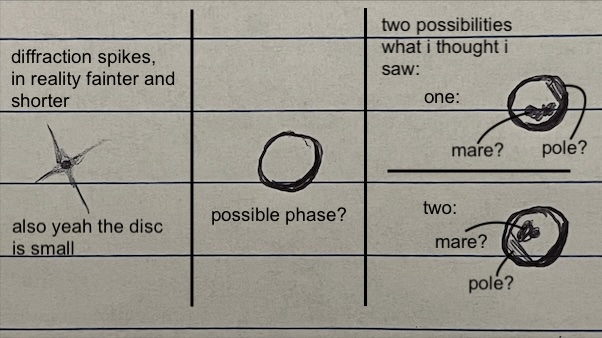got a log of observations through my telescope. later i may add some phone images through it, and some reviews of the scope and eyepieces.
thin rings and blinding gibbous - june 27th
- saturn, venus -
- am130eq, 25 x-cel lx, 8 starguider, 9 kellner, 2x barlow omni -
- clear, okay transparency, good seeing -
i saw venus and saturn for the first time since winter spring. first i found saturn with the 25. the ra slow motion is still bad, so it was difficult to switch to the 8 and adjust. but in the 8 saturn was nice. switching for the 9 with 1.5x, there was no difference. the rings were paper thin, or maybe index card thin. the rings were bright, but passing through saturn they left a black line, i guess just because the body of saturn is so much brighter than the rings, that contrast creates the illusion. i took a photo.

i saw titan too as a delicate non sparkling dot to the east of saturn. titan slowly vanished by 20 minutes to sunrise. i stayed with saturn for a bit then switched to venus.
even in the sunrise sky, venus was impossibly bright it seemed fake. i quickly found it in the 25, then in the 8 it became even brighter, and i could see it was barely gibbous. the light was blinding like midday sunlight on snow. i took a picture but it doesnt do the experience any justice. between the 8 and the 9 with 1.5x, there was again no difference.

eq troubles - june 22nd
- vega, m5, 5 serpentis -
- am130eq, 25 x-cel lx, 8 starguider -
- clear, good transparency, good seeing -
i recollimated on vega with the 8, collimation is still as difficult as ever with differing donuts in and out. this time, on outward focus, the donut was elongated on one corner. as if the dough of this donut was pinched and stretched from the center.
i went to m5, catching 5 serpentis in the vicinity. i struggled a lot to find m5, as in the 25 it was a discernable glow but in the 8 it was barely registered, and in swapping between the two eyepieces i had to adjust ra and dec to re find it, but there was a problem. the ra kept getting stuck badly, seizing up. i dont know if this eq mount is wearing out or if i did something to it. so effectively slow motion controls werent working that made finding m5 a chore. when i did find it, it was an okay glow, not much detail i could see. and i couldnt split 5 serpentis in the 8.
bloom and vines in cygnus - june 20th
- albireo, deneb, ngc7000, sadr, cygnus -
- am130eq, 25 x-cel lx, 12 starguider, 5x25 binoculars -
- clear, okay transparency, bad seeing -
saw albireo for the first time, looked great in both the 25 and 12, maybe i even prefered the 25. a bit more colorful than the mars regulus conjunction, but the blue star felt a little less blue than i expected, still beautiful. albireo was framed against a mildly sparse star field, i explored around in it.
while wandering around albireo, off from the eyepiece i saw a meteor, with an origin from below cygnus, and it streaked up from the horizon and to the right.
then i went to deneb and sadr, seeing even more populated and bright star fields, like a vibrant field of bright flowers amidst dark green grass.
ngc7000 was nearby, and i paid a visit but all i saw were stars, less blue than surroundings.
i took the binoculars to cygnus to see how the star fields looked where i was exploring around deneb and sadr, and the whole constellation was beautiful, there was a prominent string of star fields, spiralling like a twisting vine around under the spine of cygnus.
mars regulus conjunction - june 17th
- mars, regulus, melotte 111 -
- am130eq, 25 x-cel lx, 12 starguider -
- clear, good transparency, okay seeing -
i observed the mars and regulus conjunction with both the 25 and 12, the 25 fit better. it was nice to see just in the sky as well with zero power. i took a photo through the telescope.

then i went to the coma cluster to walk around the stars there again.
moon vs roof air - june 5th
- moon -
- am130eq, 7 x-cel lx, polarising filter -
- clear, good transparency, good seeing -
i observed the moon this night with the 7 and the polarising filter. except early on i did away with the filter, i was okay to be blinded a bit for better contrast. some sights i enjoyed were copernicus and clavius. while looking for euclides, i didnt know it was a small crater, so i thought it was the space in between the two arms of the y shaped riphaeus, but now i know its a smaller crater off from riphaeus towards the terminator, that was in shadow at the time. also i saw the bonpland and parry craters, but could only barely see the outline of fra mauro.
an earlier night, i noticed that after some time, the moon was waving more so than was expected with the good seeing that was being forecasted. the same thing happened again this night, in somewhat the same area in the sky, which is over a roof. i shifted the scope to get the moon away from the roof, and i got an extra half hour before poor seeing returned. so its just a turbulent column of air over a roof, like exhaust. now i know to avoid that direction.
the leo doublet - may 30th
- moon, beehive cluster, m67, leo triplet, melotte 111 -
- am130eq, 25 x-cel lx, 7 x-cel lx, 12 starguider, 8 starguider, 5x25 binoculars -
- clear, good transparency, good seeing -
i saw earthshine on the moon, first with the 25, then in the 7 i could differentiate the mare and lighter areas. then i went to the beehive cluster with the 25, but it was low and washed out a bit. next m67 was very faint, with almost nothing in the 25, some light in the 12, and many barely visible stars in the 7.
then i revisited the leo triplet after dark adapting for a while. in the 25 i didnt see anything, but in the 12 after some time i could eventually see one and then two galaxies. i sketched what i saw below. i kept on oscillating the declination knob to see if the faint fuzz i was seeing would also shake back and forth or if it was imagined. i got m65 this way, and m66 too but it took me longer because i thought the glow was just the star nearby. i thought i got the third galaxy but where i saw the fuzz is not in the right location.
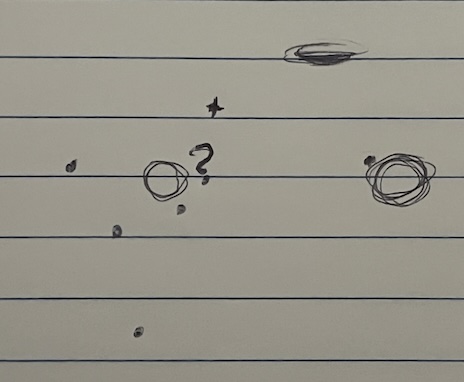
to close off i went back to melotte. i tried to aim the red dot sight based off of denebola, i aimed at an area where i got the faintest hint of a star or glow, and when i looked through the 25 i saw the cluster right there. i looked at it through the binoculars, where it fit better, and mentally matched the binocular view with the 25 view. it seems that despite the binoculars being 5x and the 25 being 26x, the binoculars only gave me a bit more than a 2x bigger tfov, which means the binoculars afov is much smaller than i thought, or one of these measurements is very off. regardless, i really enjoyed these views this night, melotte is slowly becoming my favorite open cluster.
cluster in coma - may 19th
- markarians chain, melotte 111 -
- am130eq, 25 x-cel lx, 12 starguider, 5x25 binoculars -
- clear, good transparency, okay seeing -
i could not see markarians chain at all, not with the 25, and the 12 didnt reveal any glows either. i knew from star patterns near by i was in the right area, but i did not see anything apart from a small cluster of tiny stars just south of where the chain should be, and they were definitely pin point stars. but i took a break and saw the melotte cluster through binoculars, it was a fun experience like the pleiades, but even with binoculars it didnt fit in view. the cluster as a whole had a trianglular shape, with three branches extending further out from its vertices.
revisiting bodes and cigar - may 17th
- bodes galaxy, cigar galaxy -
- am130eq, 25 x-cel lx, 12 starguider -
- clear, okay transparency, okay seeing -
just a quick visit to bodes and cigar with the 25 and 12. they were visible with no dark adaptation. the cigar was a little brighter than i remembered, and the halo of bodes smaller.
coma and canes sampler - may 14th
- melotte 111, m3, cor caroli, la superba -
- am130eq, 25 x-cel lx, 12 starguider, 8 starguider -
- clear, okay transparency, okay seeing -
i collected a list of targets from the celestial sampler that were easily reachable. i saw melotte 111 in the 25, fun to scan around. then i found m3, kind of unremarkable and a slight let down. it looked like a featureless glow regardless if it was in the 25 or the 12 or the 8. i saw cor caroli next in the 25 and 12, i could see the companion in a barely orange color. lastly la superba, in the 25 12 and 8, it had not totally a full red color like i was expecting, but a still surprising strong orange or rust hue, like mars but a bit more orange.
an ordinary tycho - may 6th
- moon -
- am130eq, 7 x-cel lx, 2x barlow omni -
- clear, good transparency, okay seeing -
more moon. i saw a few more transits but didnt note the details. the seeing was still not great. i tried to look for the hadley crater and its rille in the 7 but couldnt find it, i guess it was too small. i could see the stadius crater outline both with the 7 and with 1.5x, but it was more visible without the barlow. i also saw tycho, where it looked like any other crater in the south, just that it had a peak.
mountains and valleys - may 5th
- moon -
- am130eq, 7 x-cel lx, 2x barlow omni -
- clear, good transparency, okay seeing -
moon again, this time i skipped the filter, it was a bit annoying with all that grey scattered background. i was fine getting blinded a bit for now, at least up until the moon gets more illuminated. the seeing was supposed to be better, and it was, but after sometime it seemingly got worse, only a little better than last night. i dont remember everything, but some of my favorite sights that i remember were the alpine valley, mons pico and teneriffe, and the straight wall. also i saw three satellite transits, couldnt tell any details.
wiggly moon - may 4th
- moon -
- am130eq, 7 x-cel lx, polarising filter -
- clear, good transparency, bad seeing -
observed the moon terminator again with the 7 and filter, but the seeing was very bad and i struggled to get detailed views. twice i saw a satellite transiting the moon. the first transit, i could see it had a shape, wasnt a simple dot, but it was blurry as if it was out of focus. the second transit was too fleeting, i couldnt tell much.
back to the moon - may 3rd
- moon -
- am130eq, 25 x-cel lx, 8 starguider, polarising filter, 7 x-cel lx, 2x barlow omni -
- almost clear with intermittent thin layers, okay transparency, okay seeing -
i found the moon with the 25 and switched in the 8. it was the first time i saw the moon in the 8, the afov was a little less but otherwise a clear image. i added the polarising filter to lessen the blindness. i switched in the 7, with the filter, and viewed along the terminator for an hour. i got a little faster at getting the filter in and finding a brightness i was happy with. i wanted to use the 7 with 1.5x but barely got a few minutes before the moon set. also while using the barlow, for the first time i saw in my view the streaks i left on the edge of the barlow from cleaning with solution.
i tried to see comet swan but i didnt even know if it survived the sun and was still visible at this point, i was just looking at the stellarium apparent magnitude. i found the pleiades after half an hour of trial and error, going back and forth between guessing based off of the moon and jupiters positions, and scanning aimlessly with the 25. it was faint and very close to the horizon, i only saw the dipper shape and not much else. from there, i scanned across in azimuth hoping to find the comet, but i couldnt see any stars along the way to hop with and reference in stellarium. only when it got a bit darker could i do so, but by then the comet was set.
again i didnt see anything. i felt i saw a couple faint stars blink in and out of existence, but they were so faint i couldve imagined them. i also feel i imagined a couple of streaks in the form of faint lines, but i looked elsewhere and could kind of re imagine them at will, so definitely not real lyrids. apart from the lyrids, i again walked around the sky with binoculars for a bit.
i sat down to watch the lyrids. i saw a fireball again. it was a warm color, orangeish, saw it more or less in the vicinity of the lyrids origin, and it flew away also from that origin point, in between vega and hercules. apart from that one fireball, i didnt see anything else. intermittently i did walk around the sky with the binoculars for a few minutes at a time.
auriga clusters and lyrid fireball - april 20th
- jupiter, m38, ngc 1907, m36, m37, lyrids -
- am130eq, 12 starguider, 8 starguider, polarising filter, 9 kellner, 2x barlow omni, 5x25 binoculars -
- clear, good transparency, okay seeing -
i looked at jupiter through the 12, trying to see if i could get the grs. then with the 8 with the polarising filter, i thought i could maybe see it, but the filter was really reducing contrast. then i took off the filter and felt i could see the grs, still in passing, never consistently. i switched to the 9 with 1.5x and i could see it a little better, but i always felt i was seeing the dot a little further south than where it should be. i was going to sketch this, but i put it off for a bit too long and couldnt remember exact details by the time i got around to sketching.
at some point, either during jupiter or during auriga observations, i saw with my naked eye a meteor fly by briefly, i think one of the fireball types that people describe. i cant remember the color, or the direction. but i remember seeing it basically full north and maybe 45 degrees up, which at that point was pretty far from where the lyrids were. pretty cool to see.
anyways, i went to auriga to try m36, m37, and m38. first m38, in the 25 it was very faint, and hard to find initially, i had to reference stellarium a lot more. i saw ngc 1907 to the side. switching to the 12 made m38 less faint, i could actually see individual stars now, not a confusion of a cloud of indistinguishable stars. stars were delicate and twinkling, and averted vision helped a bit. i could see one lone star, and then a cross of star fields, and then two more swaths further away. on ngc though, i couldnt see much other than a handful of stars. switching to the 8, i could see the same stars as i did in the 12, but now there was a faint indiscernible cloud filling the space in and around the stars, i assume it is just the glow of more numerous but much fainter stars in the cluster. ngc had no difference.
i sketched the structure, the arms of m38 through the 12. the outlines are not of some nebulosity existing around the cluster, its just the regions of stars i saw.
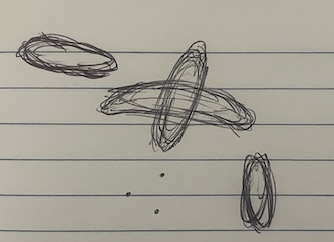
next i went to m36 in the 25, i saw a handful maybe a dozen stars, maybe a cloud of glow around it. switching to the 12, i see more stars, few dozens or more. the cluster had a triangular arrow shape, pointing westward, and had a spiralish internal structure. fainter stars were twinkling. this cluster was a little brighter than m38. i could see and split the double sigma 737, kind of resolved but faint. the other double sei 350 i could barely see with averted vision, and couldnt resolve it at all. in the 8, i could see more stars but not that much more, i could see some glow, and the sigma double i could again split, with averted vision, but the sei double just looked like a line, still super faint if not fainter than in the 12.
i barely found m37 in the 25, it was so faint it was like a galaxy or nebula, like a faint fuzzy. i could see a few stars, maybe like ten, but then the rest of the cluster was just a faint glow. in the 12 it was still faint. brightness was in between m36 and m38. i could see maybe a few dozen stars, and then a glowy collection of maybe a hundred much fainter stars, twinkling. it gets even fainter in the 8, but in it i could resolve the cloud of glow into more stars, maybe a few hundreds of stars.
while on m37, i saw with my naked eye a repeating bluish greenish flash in the sky. at first i thought it was a meteor from the lyrids because it was in that direction, but it seemed stationary. actually it was moving slowly, and the flashes slowly got fainter. so from the color of the glow and its slow movement i guess its a satellite, but i was confused why it was flashing, maybe it was a lighthouse effect and the satellite was spinning? but then why would a satellite be spinning? it was also a really bright flashing, like as bright as venus would appear more or less, so i cant imagine its a small surface reflecting light at me one at a time.
later i set up to sit and watch the lyrids for some time, but i didnt see anything. maybe its light pollution. explored the sky a little though with my eyes and binoculars.
cleaned up starguider - april 18th
- jupiter, bodes galaxy, cigar galaxy -
- am130eq, 8 starguider, 12 starguider, 25 x-cel lx -
- clear, good transparency, okay seeing -
from recent nights i realised something was wrong with the 8. less contrast and less brightness than expected, and a struggle to focus. this all sounds like a dust problem, so i looked through it both ways with light at opposite ends, and did find dust in the inside lenses, in the upper group. it showed up immediately when i unscrewed the field group, in fact it was sitting right on the air to glass surface. which means fortunately i was able to clean it out, just with the bulb air blower. i did open the barrel once while inspecting it when i first received it, i guess i accidentally got dust in there while doing so, or maybe the dust was always there and i somehow missed it?
i tried out the cleaned eyepiece on jupiter. first i used the 12 to remind myself how the image should look, then i used the 8. i think it was better, but unfortunately the seeing was still a little bad. but i feel the brightness was improved. i tried again later, but the seeing didnt improve by the time jupiter set behind a roof.
next i went to bodes and cigar. i more or less saw what i saw the other night. in the 25 i saw their shapes, and in the 12 i saw more halo and two stars on bodes. this time when i used the 8, it was a relief that i could still see those two stars, at least barely. where last night it felt the 8 was giving me sixty percent of what i could see with the 12, this night it was ninety percent.
galaxies galore - april 17th
- orion nebula, starlink, bodes galaxy, cigar galaxy, leo triplet -
- am130eq, 12 starguider, 25 x-cel lx, 8 starguider
- clear, okay transparency, okay seeing -
i tried to take a picture of the orion nebula through the 12 before orion sets too low this time of year, but orion was already too low and i was getting some sky glow.
while thinking what targets i should look at next, i saw a starlink chain fly by. the lights looked blue again like last time.
i also saw a hawk or owl or something. i was looking up and suddenly a winged and white silhouette crossed the sky directly above me, totally silent, zero sound. it was dark outside too, the sun had set a while back, and still enough light was somehow reflecting from the bottom of its wingspan to appear white against the sky, almost glowing.
back on the telescope, i tried to look for the bodes and cigar galaxies. i went to the big dipper with the red dot, found dubhe, and kicked off diagonally from the bowl the same length of the bowl itself. with the 25 i roamed around and tried to match stars up and finally came to the galaxies.
in the 25 the galaxies easily fit in the central view. they were faint, much fainter than andromeda, but not at all a challenge to perceive like the pleiades nebulosity was. cigar looked like, well a stick? less thin, maybe like a 3/4ths used up pencil, lead not far from the eraser. bodes looks more like what i remember of andromeda, a central diffuse ball of light and then still more fainter light around it, like some gaussian pattern, finishing in an elliptical shape.
switching to the 12 made the light pop a bit more against the cut down sky glow. the shapes of the galaxies remained the same for the most part, the halo of bodes maybe extended a bit. and within bodes, in i guess what should be the south western direction, i saw one maybe two faint stars embedded in the outer halo.
i switched to the 8, but the quality of the image was just much worse, in that everything became much more fainter, and somehow fuzzy, and my eye was straining trying to focus and reacquire the glows. i completely lost the faint one or two stars i was seeing in the 12. the 8 might need some cleaning.
next i wanted to try for the leo triplet. i briefly learned the leo constellation, and aimed for the hind legs of leo with the red dot. in the 25, i moved down to a certain orange star a little south of chertan, then moved a bit to the side and found my desired anchoring blue star, around which should be the triplet. but i couldnt see anything really. i switched to the 12, and i felt i saw some fuzz in the south, where i guess would be m65. but i also dont feel confident it wasnt imagined. i should try again some other night, and really sit for some time at the eyepiece to further dark adapt.
splitting castor - april 14th
- jupiter, castor, rosette nebula, ngc 2244 -
- am130eq, 25 x-cel lx, 12 starguider, 8 starguider -
- partly thin overcast, okay transparency, bad seeing -
i went to jupiter, with the 25, the 12, and the 8. the 8 was a little fuzzy, but maybe its because of the seeing.
then i went to castor. in the 25 nothing seemed unusual. then in the 12, i sort of saw the binary in castor. first it was like an elongation, then it felt more like the resolved or notched terminology people use in splitting. and then i just re focused to a much nicer focus, and then i could much more easily see two stars. it was still maybe notched, maybe in between resolved and split. it was like two points embedded in a soup of diffraction light. i switched to the 8, and focused, and then i reached a point where i felt i could say they were definitely split. through the 8, in good focus, i could see the airy diffraction ripples on the spikes of both points. also all this time, i was seeing three other further fainter stars in the neighborhood. maybe the closest of these was the third, because there are three stars of the castor system that are visible in a telescope, a, b, and c. this third star i was seeing felt still a little far from the other two, at least over ten times further. but upon checking turn left at orion, it was definitely the right star. together the triple formed a long and mildly obtuse triangle.
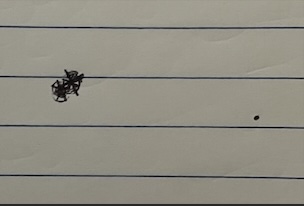
next i tried to observe the rosette nebula. 25, then 12. i found ngc 2244, but i didnt see any nebulosity. i mean of course i wouldnt, i didnt dark adapt at all and the sky is glowing from light pollution, and the full moon was about to come out. but i did enjoy a lot the star fields around the area. in the main cluster, i could tell one or two stars were more orange as well. less orange stars than m35, but maybe more than the beehive.
something ive been noticing recently is the secondary shadow dimming the view in the center. i know that this happens from reading the forums, but i thought it wouldnt be easily discernable. but now in recent nights ive been noticing it more. its like a shadow in the center 20 percent of the afov, like ive been blinded a bit in the center of my vision but the darkness doesnt recover. maybe im only now perceiving it because for some reason sky glow is higher this time of year? also, ive only really noticed it in the 12, not in the other eyepieces. maybe its there in the 25 as well, but the exit pupil in that eyepiece is so weird, other aberrations might be distracting me from it.
polarising on planetary - april 13th
- jupiter, beehive cluster -
- am130eq, 12 starguider, 2x barlow omni, polarising filter, 9 kellner, 25 x-cel lx -
- clear, good transparency, bad seeing -
for some reason i never thought to use the polarising filter on jupiter until today. so i observed jupiter with the 12 with 1.5x and with the filter. and while it felt a little scattery, i could see way more easily the stripes, and even could see the grs more often than usual. still a dot, but it came way more quickly than usual without a filter. and that is with less than ideal seeing as well.
turns out the reduction in glare also helps with phone pictures. ive always struggled to get a picture of jupiter through my phone that isnt just a bright featureless orb, but finally the filter gave me for the first time a somewhat recognisable photo of jupiter, just barely banded.
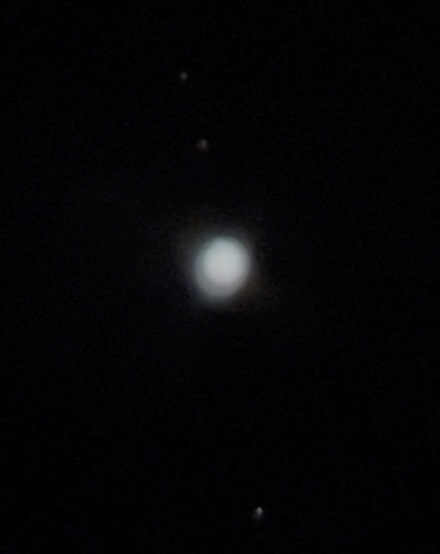

next i went to the beehive cluster. i observed through the 25, then the 12. i took a picture with the 25. especially through the 12, i could see a lot more blue or white stars than m35, like a mini pleiades.
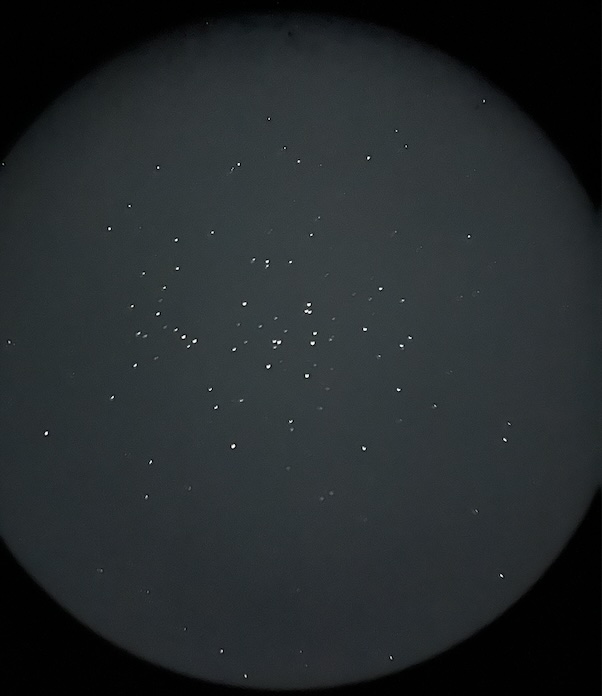
red dot relief - april 12th
- jupiter, mars, m35 -
- am130eq, 12 starguider, 2x barlow omni, 9 kellner, 25 x-cel lx -
- clear, good transparency, bad seeing -
i got a new red dot sight, so no more surviving with two and a half degrees. though the 25 is still a fun eyepiece to roam around with.
i went to jupiter straight away with the 12, then barlowed down 1.5, then switched in the 9 with 1.5x as well. i felt for some reason the 12 was a little fuzzier than usual, but maybe it was just my eyes at the moment. no grs today, but just thought to observe jupiter for a bit. and then i turned over to mars, just to pay a visit.
with the finder, i could finally aim between bright stars to find fainter objects, rather than roam with the 25 and compare with stellarium for ten minutes. i found m35 relatively easily by aiming first at alhena, then hopping over to the feet of the right twin of gemini. through the 25 and then the 12, i felt that many if not most of the stars in the cluster were yellow or orange, but after checking online it seems only a few are. still more than the pleiades i think. before closing out, i did take an impromptu picture, but it is way too poorly taken for me to want to save it in this log. maybe another night.
the great faint blob - april 8th
- jupiter, crab nebula -
- am130eq, 15 kellner, 9 kellner, 7 planetary, 12 starguider, 2x barlow omni -
- clear, okay transparency, good seeing -
no notes. while there was still some daylight, i collimated the scope. i re twisted the secondary into a better orientation. if the scope is aimed at the sky with an eyepiece, and im some inches away from the eyepiece, the image of the sky unfocuses away, and the spider refocuses into view. so i think i can check that the secondary is collimated if when i focus in and out, this spider image through the eyepiece doesnt skew and elongate. so in addition to physically looking through the focuser to get the three holdings of the primary in view, i checked the spiders image through the 15, and i repeatedly loosened, rotated slightly, and re tightened the main screw to the secondary, to get the secondarys roll correct. the spider image still changes a bit through the draw tube range, but its noticeably better now, it doesnt skew or stretch as aggressively. after the secondary, i slewed to jupiter with the 15 as a finder, then switched to the 9, and star test collimated the primary on jupiter. i dont know how necessary it is to collimate on a point source, but the collimation seemed good enough because the views were much better.
now on jupiter, i tried the planetary again, contrast was still meh. i switched to the 12 with the 1.5x, and could at some instances see the faint blob of the grs. also i dont remember if i did this in other recorded logs, but this night i used tongs and rubber bands to add moment to the focuser for finer focus. it does help significantly, but the contact has to be strong. anyways this view felt the most clear of recent nights, i could repeatedly re catch the grs when i got up from the eyepiece. in my laziness i didnt make a sketch. jupiter is only getting lower in the sky now, i really need to take some pictures and sketches soon.
before concluding, i quickly tried to look for the crab nebula with the 25. i felt i located where it should be based on the pattern of the nearby faint stars, but i couldnt see it. i switched down to the 12 and still couldnt see anything. the moon of course was out, i should try again in a week, but i wonder if sky pollution will prevent me from ever seeing any nebulae other than orion.
iota still missing the third - april 6th
- orion nebula, iota orionis -
- am130eq, 25 x-cel lx, 12 starguider, 7 x-cel lx -
- thin overcast, okay transparency, bad seeing -
again no notes. i found the orion nebula with the 25. switched to the 12. i am unaware of the variability cycles of the trapezium, i just remember that one was brighter, two in a diagonal were less bright, and the last one was fainter. i went to iota, then switched down to the 7 xcel. in the 12 i again saw only two stars, in the 7, the second star became even fainter. i was again unable to see a third.
7 xcel lx comeback - april 5th
- jupiter, moon -
- am130eq, 25 x-cel lx, 7 x-cel lx, 7 planetary, 12 starguider, 2x barlow omni, green moon filter -
- clear, okay transparency, okay seeing -
no notes again today. used the 25 to find jupiter. i enjoyed some star fields along the way. i also kept finding and confusing aldebaran for jupiter. i compared the 7 xcel, 7 planetary, and 12 with 1.5x on jupiter. i dont remember if i saw the grs. but i hadnt used the 7 xcel in a while on jupiter, and i was surprised how okay it was. i thought i remembered it as a very mushy and blurry image. it was still not as clear as the others, it felt like i was looking through a very small and fine window mesh, but the edge of the disc was still crisp, and i could see bands. i also found that the 12 without any barlow was sufficient for observing jupiter, it wasnt too small in the fov. i then went to the moon, observed craters for a bit. i tried the green moon filter, and compared it with the polarising. both did their job, just that the polarising didnt add color.
polarising filter shortcomings - april 4th
- double cluster, jupiter -
- am130eq, 25 x-cel lx, 7 x-cel lx, polarising filter -
- clear, okay transparency, okay seeing -
another day where i was too lazy to take notes. i observed the terminator of the moon with the 7 xcel. of course i used the 25 to find it. i toured around the craters and maria at the terminator with the book turn left at orion. i added the polarising filter, which did reduce the blinding moon light, but i also felt it scattered light. it certainly made the dark background brighter. when i showed a light on the filter, nothing looked dirty. maybe its just the case that any filter will scatter and lose a bit of contrast.
double cluster luck and 58 on jupiter - april 3rd
- double cluster, jupiter -
- am130eq, 25 x-cel lx, 12 starguider, 7 planetary, 15 kellner, 2x barlow omni, 9 kellner, 80a filter -
- clear, good transparency, okay seeing -
i didnt take notes this day while observing, i just wanted to causally and quickly explore a few sights.
first i looked for the double cluster. my first time. i had no red dot, so i just pointed the scope somewhere by cassiopeia and swung around blindly in the area with the 25. 2.3 degrees afov makes for a very limiting finderscope. i saw some nice star fields, but didnt find the clusters. i stepped away re aimed the telescope, eyeballing more in the middle of cassiopeia and perseus. i didnt swing more than a few degrees when it magically showed up in the 25, on my second try.
it was a nice sight. it was closer to the western horizon, a bit of daylight and sky glow, but even then there were many small and delicate stars visible. i stepped down to the 12, and the sky glow reduced, showing even more stars. both clusters fit in the 25, and in the 12 they sort of still fit, but some stars spill out of the view. conveniently, one cluster sat on top of the other in right ascension, so i just needed the ra knob to pan between the two.
i clicked a quick shaky photo in the 25 as a souvenir.
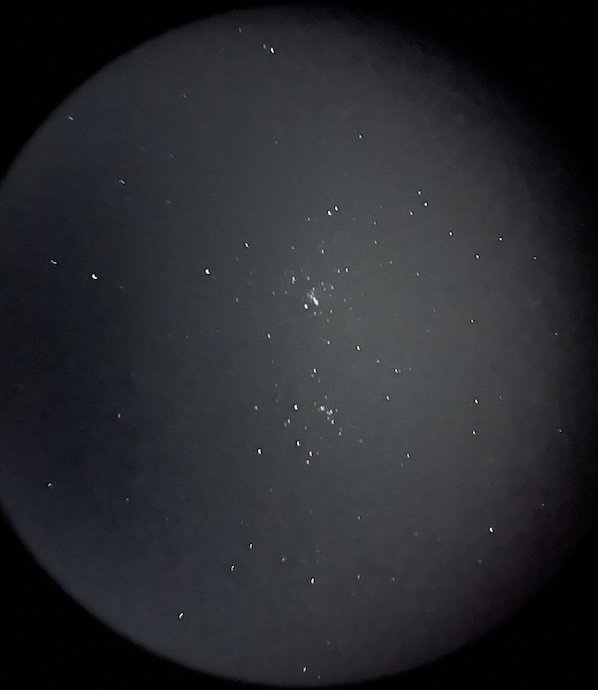
while setting up for jupiter, i saw a bunch of satellites fly over west to east. like stunt planes in formation, but much higher up and further apart. or like a bunch of alien orbs moving silently in unison, they seemed to have a slight blue or green tinge. i found out later these were from a recent starlink launch.
i found my way to jupiter with the 25. grs would be in view. i tried one more time to compare all the eyepieces for planetary observation. 7 planetary, vs 15 with 2x, vs 9 with 1.5x, vs 12 with 1.5x. i also used a stock blue filter to see if it would help better see the spot, it didnt. the 15, 9, and 12 all gave pretty good views, with a decently clear image, and i was able to see the weakening of the band near the grs, and sometimes even see the faintest dot. the 7 planetary, while giving a crisp enough disc, did not show the bands as dark as the other eyepieces. it is clear from all this testing that the planetary has worst contrast. i will think about flocking the inside of the eyepiece, maybe then it can compete.
58 planetary on the moon - april 2nd
- moon, jupiter, mars -
- am130eq, 25 x-cel lx, 7 x-cel lx, 7 planetary, 9 kellner, 2x barlow omni -
- clear, good transparency, okay seeing -
i did some more testing with the 58 planetary. i went to the moon, first with the 25 as a finderscope, since the red dot reflex stopped working, maybe the battery. once on the moon, i kept switching back and forth between the 7 xcel and the 7 planetary, keeping track of small details i could see in one, then seeing if i could see those same details in the other eyepiece. i was mostly looking around hercules and atlas, and the part of mare tranquilitatis limbward of and including cauchy. i looked for the shadows and bright spots of tiny craters, plateaus, juts, creases.
the two eyepieces are about equal in the sense that the details i barely saw in one, i barely saw the same in the other as well. but in the xcel, there were slightly more easily discernable. the planetary had a little less contrast. as in, the grays and the shadows were a bit darker in the xcel. at first i thought about if its because the planetary is technically less mag so more light coming in, but focal length difference of 7 / 6.67 means the exit pupil is only 5 percent bigger. i feel like the contrast difference is more than that, maybe not 25 percent diff but more than 5.
while on the moon, there were a couple times i saw something transit it. like a black dot zipping by. the speed makes me sure its satellites, but the size? i didnt think satellites would have a big enough angular size to notice their transits over the moon, theyre so far away. but when they left the lit crescent, they would become bright points again.
i used the 25 to find jupiter, then compared the planetary against the 9 with 1.5x. io was transiting but i couldnt see it in either eyepiece. but jupiter as a whole didnt look too different between eyepieces. also no grs today.
next i went to mars, again finding with the 25. then switched between the 9 1.5x and 7 planetary. in both eyepieces, i felt i could barely discern a dot which would be the mare acidalium. in the planetary, it was maybe a little harder to see it.
58 planetary vs poor seeing - april 1st
- moon, pleiades, jupiter -
- am130eq, 7 x-cel lx, 7 planetary, 2x barlow omni, 25 x-cel, 9 kellner -
- mostly clear, bad transparency, bad seeing -
i recently received one of those 58 degree planetary eyepieces, in 7mm. it did have some dust, i just used a dust blower to clean it off. i took off the field component and saw the inside barrel of the upper half could use baffling as others have said online. still i wanted to try this eyepiece out to see if it was an okay comfortable planetary eyepiece.
i first went to the crescent moon and focused on the mare crisium with the 7 xcel lx. specifically, i saw barely two small craters south and limbward from the picard crater, the same distance away from picard as swift and peirce are from picard. in the xcel i could barely see the limbward of the two, and could just get a suggestion of the other as a dot.
with the planetary, i first noticed a slight halo around the moon at the edge of the field, it looked like chromatic aberration but grayscale, minus the color. i wonder if this is from coma / poor fastness correction, or if its from internal reflections. on the craters, i could see again barely the limbward crater, and every now and then a glimpse of the second crater.
i switched between the eyepieces and felt i couldnt see much difference in terms of this specific excerise in crater detail, even when barlowed 1.5x. probably because of the poor seeing. i did feel though that the view through the xcel just felt nicer, im not sure why. it does have a slightly wider field, and in retrospect maybe the contrast was a bit better.
also i started noticing earthshine with my naked eye around half an hour after sunset. i wonder if i can notice it earlier during an even smaller crescent phase.
i went to the pleiades briefly with the 25 just to get a quick picture. i didnt really sit for any time at the eyepiece to observe. but with the photo i saw some reflection, maybe from my phone itself. later i noticed light scratches on the eye lens, which might have come from forcing the cap down while i packed it temporarily. fortunately i got it clean again with my lens cleaning kit.
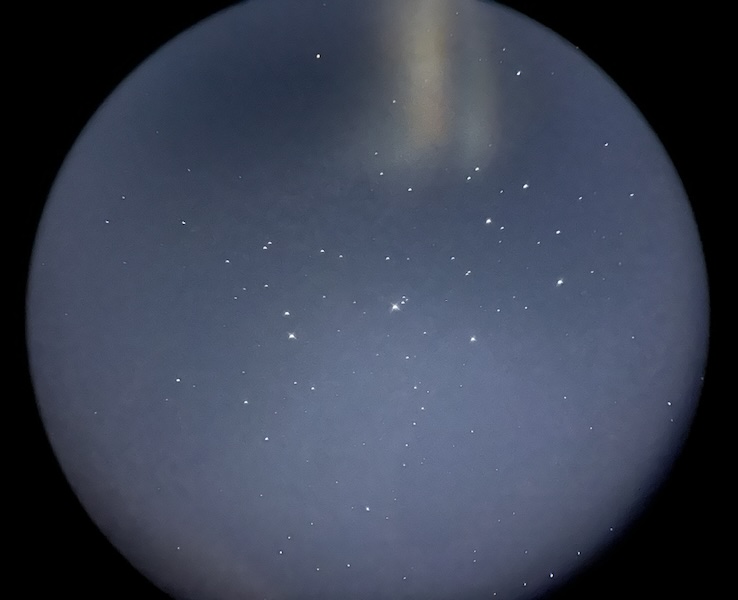
then i went to jupiter. i first compared between the 7 planetary and the 9 kellner with 1.5x barlow. the grs was facing us, and through the 9 i could see it. this time it wasnt a dot like before, i could see an actual red brown blob with some area to it. still very small and very difficult to contrast with against the rest of jupiter. i switched to the 7, and could see more or less the same thing, but it did feel somehow the image was a tad less clear, maybe reduced contrast. still sort of a toss up. with the poor seeing and the intermittent gusts swaying the telescope, the conditions werent right to compare. both eyepieces actually do show the grs, but i definitely need to test in steadier skies to see which shows more detail.
natures nd filter - march 27th
- jupiter -
- am130eq, 12 starguider, 2x barlow omni, 9 kellner -
- cloudy, bad transparency, bad seeing -
uneventful. i knew it was cloudy but i saw intermittent clear patches so i set up outside. i tried to look at jupiter, first with the 12, then barlowed down 1.5, then with the 9 with 1.5x. the grs was facing us, but i couldnt even discern the texture of the cloud bands, let alone get a glimpse of the spot. it was a cool effect though when clouds came in front of jupiter, it acted like a moon filter, for a second it felt like i could see a bit more contrast in the reduced glare.
pleiades redemption and the great faint spot - march 24th
- sirius, pleiades, mars, jupiter -
- am130eq, 9 kellner, 25 x-cel lx, 12 starguider, 2x barlow omni -
- clear, good transparency, good seeing -
i tried to collimate the primary on sirius with the 9 and found again the inward and outward donuts disagreed. i just struck a compromise between the inward and outward donuts and left it at that, maybe i will redo the secondary another week or month.
i went to the pleiades with the 25, when i was unfocused outward some stars had really messed up donuts, but closer to the right focus draw length it was fine.
i switched to the 12, and dark adapted. this time i could see a glow around the stars without averted vision, the texture of light reminded me of the orion nebula, so i felt i was definitely seeing nebulosity on these stars. also when i slewed away from the pleiades the sky became a bit darker, and when coming back it became brighter again. i also saw the light delicate trail of stars southwest of the dipper of pleiades. i could tell most of them were just barely orange in color.
but seeing nebulosity on meroppe is still difficult. maybe theres the faintest thinnest light around it. i switched to the 9 to cut out more light pollution, and after a few moments i felt i was seeing a paper thin glow stretching some few arc minutes around it. or its my imagination...
also while on pleiades i unintentionally caught in the view three satellites and even a plane. the plane was a jumpscare, looked like an ominous v shape of lights pass through, i thought it was a satellite constellation at first.
i went over to mars still with the 9, the image was very spiky. not diffraction spikes. the disc was still there, but there was a spiky halo or something around it, even though i felt i was focused. spikes almost as big as mars itself. i think this is the effect of the less perfect outer edge of the primary that i read about online. not an astromaster shortcoming, i think its common or just guaranteed with mirrors.
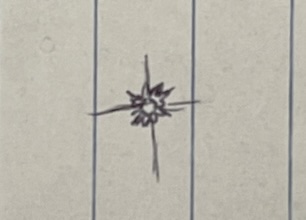
i went over to jupiter once i knew the grs was in view. with the 9 and 1.5 barlow, i noticed a weakening of the south band right where it contacts the left edge of the disc. after some ten or so minutes, i could see a hole in the dark band, and every now and then i felt i saw a faint dot just south of the band, directly under the hole. i switched to the 12 with the 1.5 and felt i could see the same detail almost, but the dot showed up less. jupiter was definitely bigger in the 9, and it felt a tad cleaner.
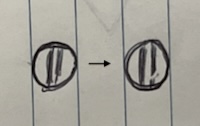
i noticed at some point the view was getting less crystal clear, in both eyepieces. i thought my eye was getting strained. but the halo was getting weird too. then i realised jupiter was setting behind a roof. so thats what gradual setting looks like through a telescope, less and less definiton.
the collimation to end all collimations - march 23rd
- sirius, jupiter -
- am130eq, 15 kellner, 2x barlow omni, 12 starguider, 9 kellner -
- clear, good transparency, okay seeing -
i read online that collimation donut images differing between inward and outward focus means the secondary mirror is out of alignment. makes sense to me, the donut would have a different appearance at every point through the focus range if the focuser axis and actual light path from the secondary were not aligned.
while sunlight was still out, i actually collimated the primary first before the secondary, because looking down directly through the tube i saw the reflected image of the secondary was way off center from the real secondary. i adjusted the screws at the back until the secondary and its reflection were roughly overlapped on each other.
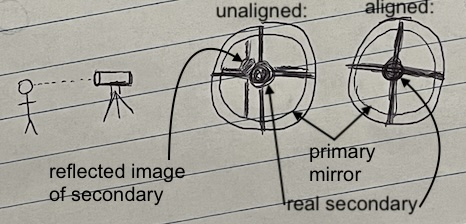
for an hour i adjusted the secondary. looking through a retracted focuser, the image of the primary would move unpredictably. tightening a screw would move it one way, then move it in the opposite way a minute later. two things were happening. one, if the collimation screws were a little loose, the secondary cell sags. two, unless everything was as tightened as can be, to the point of almost stripping screws, spinning a screw can impart a spin the entire cell about its axis. it doesnt matter if a screw is getting tightened, or loosened, the whole cell would spin a small amount counter clockwise. frustrating.
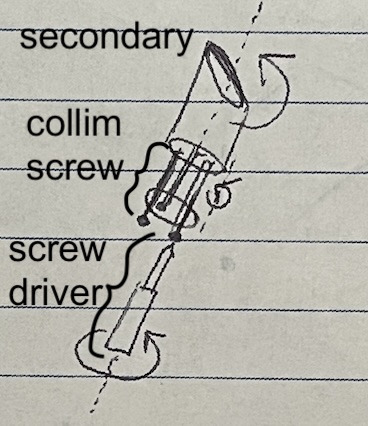
the process i repeated was:
-
slightly unscrew the main screw, the one connected to the cell
-
hold the cell and spin it till the image of the primary through the focuser tube is vertically well aligned
-
rotate the cell a small amount clockwise as to counteract any future spins counter clockwise
-
tighten back the main screw down hard while holding the cell in the desired orientation as best as possible
-
in small increments, adjust the secondary collimation screws with equal amounts tightening and loosening (tighten one, loosen the other two, or vice versa)
-
maybe screw down the main cell screw again
-
repeat until happy with the image of the primary
i repeated this process for an hour. i felt the secondary was okay, and moved to the primary. i star collimated on sirius with the 15. for future reference, so i dont get it mixed up, tightening a primary collimation screw will push the shadow of the secondary back away from whatever side the screw is on. and for secondary collimation, only when everything is extremely tight, tightening a screw will push the image in the opposite direction the screw is located in.
i went to jupiter in the 15 and saw still again the donuts were different on inward and outward focus. but actually its just that the outward donut exaggerated the unevenness that was there on inward. i didnt re collimate, maybe another night.
i experimented with higher mag again on jupiter, now that seeing and transparency was better. the size looked all about the same through 15/2, 12/1.5, and 9/1.5 (really 10/1.5). details same too, i could discern the texture of the cloud bands equally. the 12 was obviously most comfortable. jupiter was slightly bigger in the 9, but maybe i would be happy after all with an 8 starguider. but the tmb clones also have a comfortable cup, and could offer closer mag to the 9/1.5.
odd donuts and magnification on jupiter - march 21st
- jupiter -
- am130eq, 7 x-cel lx, 9 kellner, 2x barlow omni, 12 starguider -
- clear but thin overcast, okay transparency, okay seeing -
i wanted to test the upper limit of magnifications with eyepieces. i focused on jupiter. on outward focus again the collimation felt off, and again inward focus looked better. in observing, i aimed to reach focus from inside. the 7 (6.5) was mushy and kind of dimmer than i expected. the 9 (10) with 1.5x was good but not as excellent as i remember from previous observations. there was the thinnest cloud layer over the sky, or haze, maybe thats the reason. but otherwise i could reach a clear sharp disc. sometimes the disc was sharper with a bit of unfocused halo. the 12 with 1.5x was the same performance as the 9. maybe its circumstantial, but with 12 i could see the shimmering of okay seeing. the 6.5 was not great, but its a toss up between the 12 and 9 barlowed down 1.5x. somehow jupiter in the 12 looked bigger than in the 9. maybe the afov difference affects this illusion. i need to test again in better seeing.
wheres the nebulosity pleiades? - march 20th
- sirius, pleiades, orion nebula, iota orionis -
- am130eq, 9 kellner, 25 x-cel lx, 12 starguider -
- clear, okay transparency, okay seeing -
maybe light pollution was a bit higher. i collimated on sirius with the 9. after collimating with focuser inside, when i focused outside the donut image was off again. i collimated outside and then inside was also fine, i dont know what happened. the uneven flair on sirius went away, so i didnt see pup after all that other night.
with the 25, i roughly aimed at the pleiades and followed a trail of light stars and came to the cluster. i could see again the middle stars three companions, one of which i couldnt see the other hazy night.
after ten minutes, i still couldnt see any nebulosity, so i switched to the 12. still after thirty minutes i couldnt see nebulosity directly. when i averted my vision, the bright stars had glows, which i thought could be nebulosity, but atlas and pleione had glow too, even if less glow, so im not sure. the light pollution may be washing out nebulosity.
i saw ads 2755 and could split them easily, they were wide apart. the north one had barely a warmer color, and the other was not as blue as the main stars.
pleiades set, then i switched to the orion nebula just to look at it before going inside. the nebula was bright and fuller from the dark adapting. i went south to iota orionis and could barely see two stars, a brighter one and then a fainter star with a bit of distance in between. the second was very faint, i switched to the 9 kellner and i almost couldnt see it, because of fogging and the less light coming in. after reading up on iota, it seems there is a third star, i guess i just saw the a and c stars.
averted vision in orion - march 18th
- orion nebula, jupiter -
- am130eq, 25 x-cel lx, 12 starguider, 2x barlow omni -
- clear, okay transparency, okay seeing -
i went to the orion nebula. after dark adapting for a bit, in the 25 the light was good, but with averted vision it really popped and glowed. it was the first time i deliberately used averted vision. with the 12 i saw an extra fainter star, and outlined the dark 'finger', and breadth of the nebula.

i went to jupiter with the 12. i saw a moon very close to the disc. i added the 1.5 barlow and saw a second moon even closer.
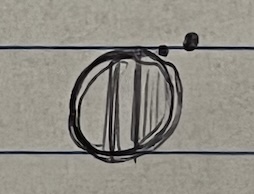
while focusing i realised there was uneven flaring and when focused far in or out i saw i was uncollimated a bit. maybe i did not see the pup elongation the other night, just the uneven flare.
on another note, the 12 barlowed down 1.5 made a good image of jupiter, compared to when i tested some time ago the 12 with 2x. so its not the case that the 12 has too many lenses and makes mushy images, its just that 108x is too much magnification and 81x is fine. to sum up past mag testing, 5 is too much, 9/10 with 1.5 is great (9 kellner is maybe 10 actually), 12 with 2 is mushy, unfocused halo, 6.5 is less mushy, and 12 with 1.5 is good. so the ideal max mag for this telescope is between 81 and 98, focal length between 6.6 and 8.
haze and gibbous mars - march 15th 2025
- orion nebula, pleiades, jupiter, sirius, mars -
- am130eq, 25 x-cel lx, 9 kellner, 2x barlow omni -
- clear but thin overcast, bad transparency, okay seeing -
it was supposed to be clear skies, even with ecmwf. but there was haze or some thin cloud layer. i first tried the orion nebula but it was washed. that was in the 25, but i dont think the 12 wouldve helped. then i saw the pleiades, still washed out. the stars were there, just less popped out, and the middle stars companions were fainter.
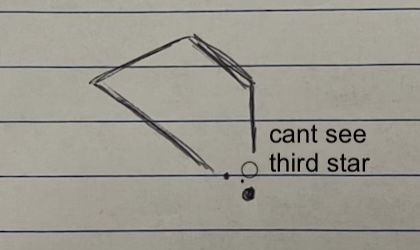
next i went to jupiter, still in the 25, looked nice and bright. then i saw it with with the 9 kellner and the 1.5 barlow. i had to spend more time at the eyepiece but i felt details were more clear when there was a bit of a halo:
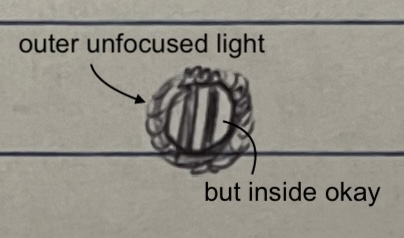
also the focuser is messed up, it clicks up and down, i shouldnt have tried to mod the focuser, the slop before was more manageable than this now. anyways next i did sirius, very bright and beautiful light. maybe the pup was in the elongation or its an uneven flair...
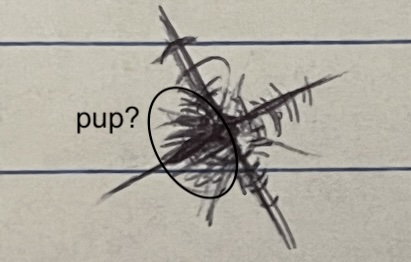
then i did mars. spent some time at it, focuser in and out. i feel like all the details are my imagination. but upon checking out stellarium, i was right about the phase at least.
